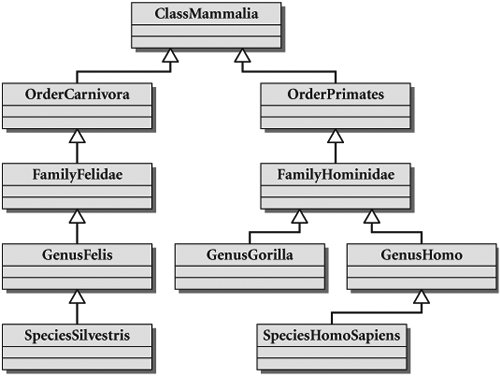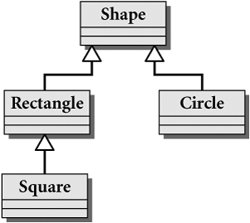Derivation from an Abstract Base Class
An abstract base class is used to encapsulate common features of concrete classes. An abstract class cannot be instantiated. Nevertheless, this scheme is quite useful and efficient for organizing our knowledge of the vastly complex biological world. In the simplified taxonomic organization chart shown in Figure 6.2, we can see that a primate is a mammal that has certain additional characteristics, a gorilla is a hominid with certain additional characteristics, and so forth.
Figure 6.2. Animal taxonomy

A concrete class represents a particular kind of entity, something that really exists and can be instantiated. For example, walking through the woods you will never encounter a real, live animal that is completely described by the designation Carnivora or Felidae. You may, depending on where you walk, find a lion, a siamese cat, or a common housecat (Felis silvestris). But there is no instance of a Hominidae (i.e., of a base class) in the concrete world that is not also an instance of some particular species. If a biologist ever finds a concrete instance that does not fit into an existing species definition, then that biologist may define and name a new species and become famous.
To summarize, the more general categories (class, order, family, subfamily) are all abstract base classes that cannot be instantiated in the concrete world. They were invented by people to help with the classification and organization of the concrete classes (species).
Back to Programming
At first it might seem counterintuitive to define a class for an abstract idea that has no concrete representative. But classes are groupings of functions and data, and are useful tools to enable certain kinds of organization and reuse. Categorizing things makes the world simpler and more manageable for humans and computers.
As we study design patterns and develop frameworks and class libraries, we will sometimes design inheritance trees where only the leaf nodes can be instantiated, and the inner nodes are all abstract.
Once again, an abstract base class is a class that is impossible and/or inappropriate to instantiate. Features of a class that tell the compiler to enforce this rule are:
- There is at least one pure virtual function.
- There are no public constructors.
Figure 6.3 shows a class hierarchy with an abstract base class, Shape. Shape is abstract because it contains pure virtual functions.
Figure 6.3. Shapes UML diagram

A pure virtual function has the following declaration syntax:
virtual returnType functionName(parameterList)=0;
Example 6.13 shows the base class definition.
Example 6.13. src/derivation/shape1/shapes.h
[ . . . . ]
class Shape { <-- 1
public:
virtual double area() = 0; <-- 2
virtual QString getName() = 0;
virtual QString getDimensions() = 0;
virtual ~Shape() {}
};
|
getName(), area(), and getdimension() are all pure virtual functions. Because they are defined to be pure virtual, no function definition is required in the Shape class. Any concrete derived class must override and define all pure virtual base class functions for instantiation to be permitted. In other words, any derived class that does not override and define all pure virtual base class functions is, itself, an abstract class. Example 6.14 shows the derived class definitions.
Example 6.14. src/derivation/shape1/shapes.h
[ . . . . ]
class Rectangle : public Shape {
public:
Rectangle(double h, double w) :
m_Height(h), m_Width(w) {}
double area();
QString getName();
QString getDimensions();
protected: <-- 1
double m_Height, m_Width;
};
class Square : public Rectangle {
public:
Square(double h) : Rectangle(h,h) {} <-- 2
double area();
QString getName();
QString getDimensions();
};
|
Rectangle, Circle, and Square are derived from Shape. Their implementations are shown in Example 6.15.
Example 6.15. src/derivation/shape1/shapes.cpp
#include "shapes.h"
double Circle::area() {
return(3.14159 * m_Radius * m_Radius);
}
double Rectangle::area() {
return (m_Height * m_Width);
}
double Square::area() {
return (Rectangle::area()); <-- 1
}
[ . . . . ]
|
We provide some client code to exercise these classes in Example 6.16.
Example 6.16. src/derivation/shape1/shape1.cpp
#include "shapes.h"
#include
#include
void showNameAndArea(Shape* pshp) {
qDebug() << pshp->getName()
<< " " << pshp->getDimensions()
<< " area= " << pshp->area();
}
int main() {
Shape shp; <-- 1
Rectangle rectangle(4.1, 5.2);
Square square(5.1);
Circle circle(6.1);
qDebug() << "This program uses hierarchies for Shapes";
showNameAndArea(&rectangle);
showNameAndArea(&circle);
showNameAndArea(&square);
return 0;
}
|
In the global function showNameAndArea() the base class pointer, pshp, is successively given the addresses of objects of the three subclasses. For each address assignment, pshp polymorphically invokes the correct getName() and area() functions. Example 6.17 shows the output of the program.
Example 6.17. src/derivation/shape1/shape.txt
This program uses hierarchies for Shapes RECTANGLE Height = 4.1 Width = 5.2 area = 21.32 CIRCLE Radius = 6.1 area = 116.899 SQUARE Height = 5.1 area = 26.01 |
Inheritance Design |
Part I: Introduction to C++ and Qt 4
C++ Introduction
- C++ Introduction
- Overview of C++
- A Brief History of C++
- Setup: Open-Source Platforms
- Setup: Win32
- C++ First Example
- Input and Output
- Identifiers, Types, and Literals
- C++ Simple Types
- C++ Standard Library Strings
- Streams
- The Keyword const
- Pointers and Memory Access
- const* and *const
- Reference Variables
- Points of Departure
- Review Questions
Classes
- Classes
- Structs
- Class Definitions
- Member Access Specifiers
- Encapsulation
- Introduction to UML
- Friends of a Class
- Constructors
- Subobjects
- Destructors
- The Keyword static
- Copy Constructors and Assignment Operators
- Conversions
- const Member Functions
- Review Questions
Introduction to Qt
- Introduction to Qt
- Example Project: Using QApplication and QLabel
- Makefile, qmake, and Project Files
- Getting Help Online
- Style Guidelines and Naming Conventions
- The Qt Core Module
- Streams and Dates
- Points of Departure
- Review Questions
Lists
Functions
- Functions
- Function Declarations
- Overloading Functions
- Optional Arguments
- Operator Overloading
- Parameter Passing by Value
- Parameter Passing by Reference
- References to const
- Function Return Values
- Returning References from Functions
- Overloading on const-ness
- Inline Functions
- Inlining versus Macro Expansion
- Review Questions
Inheritance and Polymorphism
- Inheritance and Polymorphism
- Simple Derivation
- Derivation with Polymorphism
- Derivation from an Abstract Base Class
- Inheritance Design
- Overloading, Hiding, and Overriding
- Constructors, Destructors, and Copy Assignment Operators
- Processing Command-Line Arguments
- Points of Departure
- Review Questions
Part II: Higher-Level Programming
Libraries
- Libraries
- Code Containers
- Reusing Other Libraries
- Organizing Libraries: Dependency Management
- Installing Libraries: A Lab Exercise
- Frameworks and Components
- Review Questions
Introduction to Design Patterns
QObject
- QObject
- QObjects Child Managment
- Composite Pattern: Parents and Children
- QApplication and the Event Loop
- Q_OBJECT and moc: A Checklist
- Values and Objects
- tr() and Internationalization
- Point of Departure
- Review Questions
Generics and Containers
- Generics and Containers
- Generics and Templates
- Containers
- Managed Containers, Composites, and Aggregates
- Implicitly Shared Classes
- Generics, Algorithms, and Operators
- Serializer Pattern
- Sorted Map Example
- Review Questions
Qt GUI Widgets
- Qt GUI Widgets
- Widget Categories
- QMainWindow and QSettings
- Dialogs
- Images and Resources
- Layout of Widgets
- QActions, QMenus, and QMenuBars
- QActions, QToolbars, and QActionGroups
- Regions and QDockWidgets
- Views of a QStringList
- Points of Departure
- Review Questions
Concurrency
- Concurrency
- QProcess and Process Control
- Threads and QThread
- Summary: QProcess and QThread
- Review Questions
Validation and Regular Expressions
- Validation and Regular Expressions
- Validators
- Regular Expressions
- Regular Expression Validation
- Review Questions
Parsing XML
Meta Objects, Properties, and Reflective Programming
- Meta Objects, Properties, and Reflective Programming
- Anti-patterns
- QMetaObject: The MetaObject Pattern
- Type Identification and qobject_cast
- Q_PROPERTY Macro: Describing QObject Properties
- QVariant Class: Accessing Properties
- DataObject: An Extension of QObject
- Property Containers: PropsMap
- Review Questions
More Design Patterns
- More Design Patterns
- Creational Patterns
- Serializer Pattern Revisited
- The Façade Pattern
- Points of Departure
- Review Questions
Models and Views
- Models and Views
- M-V-C: What about the Controller?
- Dynamic Form Models
- Qt 4 Models and Views
- Table Models
- Tree Models
- Review Questions
Qt SQL Classes
Part III: C++ Language Reference
Types and Expressions
- Types and Expressions
- Operators
- Evaluation of Logical Expressions
- Enumerations
- Signed and Unsigned Integral Types
- Standard Expression Conversions
- Explicit Conversions
- Safer Typecasting Using ANSI C++ Typecasts
- Run-Time Type Identification (RTTI)
- Member Selection Operators
- Point of Departure
- Review Questions
Scope and Storage Class
- Scope and Storage Class
- Declarations and Definitions
- Identifier Scope
- Storage Class
- Namespaces
- Review Questions
Statements and Control Structures
Memory Access
- Memory Access
- Pointer Pathology
- Further Pointer Pathology with Heap Memory
- Memory Access Summary
- Introduction to Arrays
- Pointer Arithmetic
- Arrays, Functions, and Return Values
- Different Kinds of Arrays
- Valid Pointer Operations
- What Happens If new Fails?
Chapter Summary
Inheritance in Detail
- Inheritance in Detail
- Virtual Pointers and Virtual Tables
- Polymorphism and virtual Destructors
- Multiple Inheritance
- Point of Departure
- public, protected, and private Derivation
- Review Questions
Miscellaneous Topics
Part IV: Programming Assignments
MP3 Jukebox Assignments
- MP3 Jukebox Assignments
- Data Model: Mp3File
- Visitor: Generating Playlists
- Preference: An Enumerated Type
- Reusing id3lib
- PlayListModel Serialization
- Testing Mp3File Related Classes
- Simple Queries and Filters
- Mp3PlayerView
- Models and Views: PlayList
- Source Selector
- Persistent Settings
- Edit Form View for FileTagger
- Points of Departure
Part V: Appendices
MP3 Jukebox Assignments
- MP3 Jukebox Assignments
- Appendix A. C++ Reserved Keywords
- Appendix B. Standard Headers
- Appendix C. The Development Environment
- Section C.1. The Preprocessor: For #including Files
- Section C.2. Understanding the Linker
- Section C.3. Debugging
- Section C.4. Qt Assistant and Designer
- Section C.5. Open-Source IDEs and Development Tools
Bibliography
MP3 Jukebox Assignments
EAN: 2147483647
Pages: 268
- ERP Systems Impact on Organizations
- The Effects of an Enterprise Resource Planning System (ERP) Implementation on Job Characteristics – A Study using the Hackman and Oldham Job Characteristics Model
- Context Management of ERP Processes in Virtual Communities
- Intrinsic and Contextual Data Quality: The Effect of Media and Personal Involvement
- A Hybrid Clustering Technique to Improve Patient Data Quality
- Chapter I e-Search: A Conceptual Framework of Online Consumer Behavior
- Chapter III Two Models of Online Patronage: Why Do Consumers Shop on the Internet?
- Chapter VI Web Site Quality and Usability in E-Commerce
- Chapter IX Extrinsic Plus Intrinsic Human Factors Influencing the Web Usage
- Chapter X Converting Browsers to Buyers: Key Considerations in Designing Business-to-Consumer Web Sites
